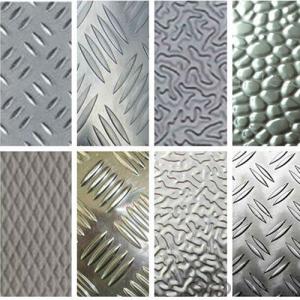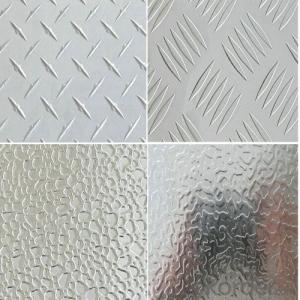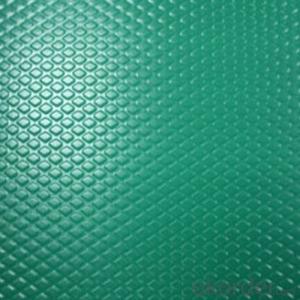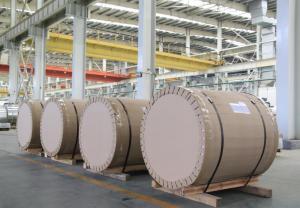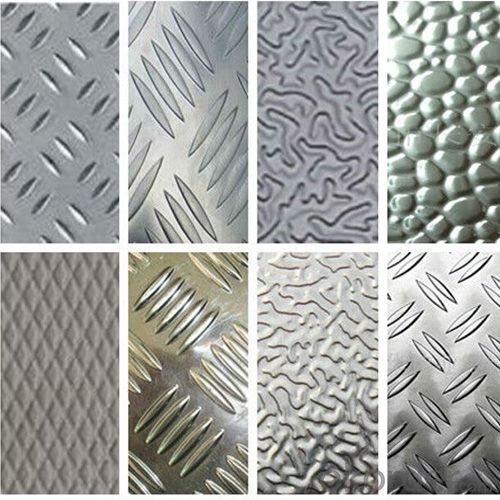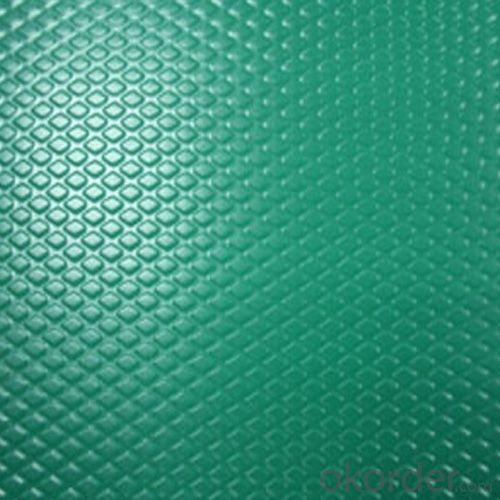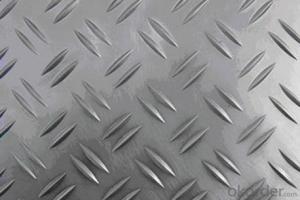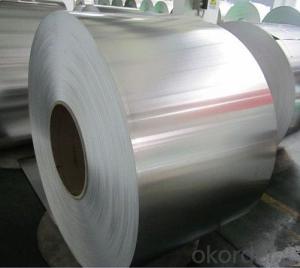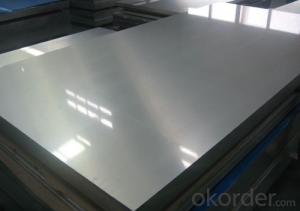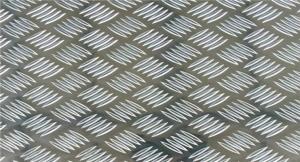Anti-Slip Aluminium/Alu Alloy Embossed Checkered Tread Coated Aluminum Coil Sheet
- Loading Port:
- Shanghai
- Payment Terms:
- TT or LC
- Min Order Qty:
- 5 m.t.
- Supply Capability:
- 10000 m.t./month
OKorder Service Pledge
OKorder Financial Service
You Might Also Like
Specification
1. Specifications of Anti-Slip Aluminium/Alu Alloy Embossed Checkered Tread Coated Aluminum Coil Sheet.
Alloy | AA1xxx(1050,1060,1070,1100 etc.) |
AA3xxx(3003,3004,3005,3105 etc.) | |
AA5xxx(5005,5052,5083,5754 etc.) | |
Temper | H14,H16,H18,H22,H24,H26,H32 |
Thickness | 0.2-20mm |
Width | 10mm-1500mm |
Embossed | Diamond, Stucco, Three/Five Bars |
Standard | GB/T3880-2012,EN485, ASTM B209 |
Application | Anti-Skid Floor, Decoration Floor etc |
Special specification or color is available as per customers’ requirement | |
2. Uage/Application of Anti-Slip Aluminium/Alu Alloy Embossed Checkered Tread Coated Aluminum Coil Sheet
The embossed aluminum coil/sheet are widely used for decorative purpose in construction, packing and appliance. It is also very commonly used for anti-splippery purposes in vehicles and public places.
3. Packaging & Delivery of Anti-Slip Aluminium/Alu Alloy Embossed Checkered Tread Coated Aluminum Coil Sheet
Seaworthy package, plastic bag covered inside, carton wrapped outside, paper core, on the wooden pallet. Pallet weight: 2000-25000KG.
4. Production Flow of Anti-Slip Aluminium/Alu Alloy Embossed Checkered Tread Coated Aluminum Coil Sheet
Melting-Rolling- Cutting- Annealing--Packing
5.FAQ
We have organized several common questions for our clients,may help you sincerely:
① How about your company?
A world class manufacturer & supplier of aluminum coil and alloy blanks. Aluminum production base is comprised of 18 aluminum annealers, 10 coil and foil mills, 4 continuous production lines, 2 hot rolling production line and 3 prepainted lines. Export 5000 tons per month to Asia, America and Middle East. Always do the best for our clients.
②Can you guarantee the quality of the products?
We are responsible for the quality of materials to get a long-term cooperation with clients in a reasonable period of time and we are glad to arrange and coordinate any third party inspection for you.
③What is the delivery time after purchase?
35 day after receiving client’s deposit or correct LC.
- Q: Are aluminum sheets suitable for beverage cans?
- Yes, aluminum sheets are suitable for beverage cans. Aluminum is lightweight, resistant to corrosion, and can be easily shaped into cans. It also provides a protective barrier against light and air, ensuring the quality and freshness of the beverages inside.
- Q: Can aluminum sheets be hydroformed?
- Yes, aluminum sheets can be hydroformed.
- Q: This question asks about the distinctions between aluminum sheets that are produced domestically versus those that are imported.
- <p>Yes, there can be differences between domestic and imported aluminum sheets. These differences may include quality standards, material composition, thickness, surface finish, and price. Domestic sheets are often produced to meet local standards and regulations, while imported sheets may adhere to different international standards. The manufacturing process and raw materials used can also vary, leading to differences in durability, strength, and workability. Additionally, imported sheets might have different certifications or come from countries with lower production costs, which can affect the price. However, it's important to note that not all imported aluminum sheets are of lower quality; some may be of higher quality or have specific characteristics that are not available domestically.</p>
- Q: How is aluminum obtained from its ore?
- Aluminum is obtained from its ore through a process called Bayer's process. The ore, known as bauxite, is first crushed and then mixed with a hot solution of sodium hydroxide. This reaction causes the aluminum oxide in the ore to dissolve, forming sodium aluminate. The impurities in the ore, such as iron oxide and silica, remain insoluble. Next, the solution is filtered to remove the insoluble impurities, leaving behind a clear liquid containing sodium aluminate. This liquid is then cooled and treated with carbon dioxide gas, which converts the sodium aluminate into aluminum hydroxide. The aluminum hydroxide is then heated to form alumina or aluminum oxide. This process, known as calcination, involves heating the aluminum hydroxide at high temperatures to remove any remaining water and impurities. Finally, the alumina is mixed with a molten cryolite, which acts as a solvent, and then electrolyzed. Electrolysis involves passing an electric current through the molten mixture, causing the aluminum ions to migrate to the cathode, where they are reduced to form molten aluminum metal. The molten aluminum is then collected and cooled to solidify into ingots or other desired shapes. In summary, aluminum is obtained from its ore by first extracting the aluminum oxide using sodium hydroxide, followed by purification and conversion into alumina through calcination. The alumina is then electrolyzed using a molten cryolite, resulting in the production of molten aluminum metal.
- Q: which has more volume? a kg of gold or a kg of aluminum? please explain in physics terms
- The density of gold is higher than the density of aluminum, so a kg of gold would take up less space than a kg of aluminum. But to answer your homework, you should look up the specific gravities of each of these metals, and figure out the volume of a kg of each....
- Q: What are the different methods of surface cleaning for adhesive bonding of aluminum sheet?
- There are several methods of surface cleaning for adhesive bonding of aluminum sheet. These methods include mechanical cleaning, chemical cleaning, and plasma cleaning. 1. Mechanical Cleaning: This method involves physically removing any contaminants or debris from the surface of the aluminum sheet. It can be done using various techniques such as sanding, grinding, or scrubbing with abrasive materials. Mechanical cleaning is effective in removing loose particles and surface imperfections, but it may not be able to eliminate all types of contaminants. 2. Chemical Cleaning: Chemical cleaning involves the use of specific cleaning agents or solvents to remove contaminants from the aluminum surface. These cleaning agents can dissolve or dislodge dirt, grease, oil, or other organic substances. Chemical cleaning is often combined with mechanical cleaning to ensure thorough surface preparation. It is important to choose a cleaning agent that is compatible with both the adhesive and the aluminum sheet to avoid any adverse reactions. 3. Plasma Cleaning: Plasma cleaning is a more advanced method that uses ionized gases to clean and activate the surface of the aluminum sheet. The plasma generates reactive species that can break down and remove contaminants from the surface, while also creating active sites for better adhesion. Plasma cleaning is effective in removing organic and inorganic contaminants, as well as oxide layers that may hinder bonding. Each method has its advantages and limitations, and the choice of surface cleaning method depends on the specific requirements of the adhesive bonding process. It is important to carefully evaluate the surface condition and the type of contaminants present to determine the most suitable cleaning method. Additionally, proper surface preparation techniques should be followed to ensure successful adhesive bonding of aluminum sheet.
- Q: What are the different cutting tools used for aluminum sheets?
- There are several cutting tools that can be used for aluminum sheets, including power shears, hacksaws, circular saws with carbide-tipped blades, and plasma cutters. Each tool has its own advantages and is suitable for different applications depending on the thickness and size of the aluminum sheet.
- Q: What are the different grades of aluminum sheets?
- In the market, a variety of aluminum sheet grades can be found, each having its own unique properties and uses. Some commonly used grades are 3003, 5052, and 6061. Grade 3003, a non-heat treatable alloy, displays high resistance against corrosion. It finds its application in scenarios where corrosion resistance is crucial, such as packaging, cooking utensils, and chemical equipment. Grade 5052, also non-heat treatable, offers exceptional corrosion resistance along with strength and durability. This makes it suitable for marine applications, transportation equipment, and architectural purposes. Grade 6061, a heat treatable alloy, combines good corrosion resistance with high strength. It is extensively used in structural applications like aircraft components, automotive parts, and construction materials. In addition to these grades, there are specialized aluminum alloys like 2024, 7075, and 5083, catering to specific properties required in particular industries or applications. To ensure the right grade of aluminum sheet for your project, it is crucial to consider its specific requirements, as each grade possesses its own strengths and limitations. Seeking advice from a knowledgeable supplier or expert can assist in determining the most suitable grade for your needs.
- Q: I just built a stone wall with illuminated glass features embedded, and to make them shine evenly, I had all sides but the visual one wrapped in industrial thickness aluminium foil. One week later, the foil has disintegrated. I have used type 10 Portland. What is going on?
- I believe your problem is that concrete acts as a fairly strong base (this is especially true of mortar mixes). It is well known that strong base will react with an active metal like aluminium and produce hydrogen gas as a byproduct. The representative reaction is: 2Al+6NaOH==2Na3AlO3+3H2, This reaction is fairly rapid and can even cause an explosive buildup of hydrogen gas in a non-ventillated area.
- Q: What are the different grades of aluminum sheet?
- The market offers a variety of aluminum sheet grades, each possessing unique properties and applications. Some notable grades are as follows: 1. Grade 1100: Renowned for its exceptional resistance to corrosion and high thermal conductivity. It finds common usage in chemical equipment, reflectors, heat exchangers, and electrical conductors. 2. Grade 3003: This grade contains manganese, rendering it highly resistant to corrosion. It is frequently employed in cooking utensils, storage tanks, and architectural trim. 3. Grade 5052: Exhibits good formability and high fatigue strength. It is frequently utilized in marine applications such as boat hulls and components, as well as in aircraft fuel tanks and structural parts. 4. Grade 6061: Distinguished by its excellent strength-to-weight ratio and favorable machinability. It is commonly employed in automotive parts, bicycle frames, and structural components. 5. Grade 7075: Possesses exceptional strength and toughness, making it suitable for aerospace applications, including aircraft wings and fuselage structures. Every aluminum sheet grade possesses unique characteristics and is selected based on specific application requirements. Factors such as corrosion resistance, strength, formability, and machinability should be carefully considered when determining the appropriate grade.
Send your message to us
Anti-Slip Aluminium/Alu Alloy Embossed Checkered Tread Coated Aluminum Coil Sheet
- Loading Port:
- Shanghai
- Payment Terms:
- TT or LC
- Min Order Qty:
- 5 m.t.
- Supply Capability:
- 10000 m.t./month
OKorder Service Pledge
OKorder Financial Service
Similar products
Hot products
Hot Searches
Related keywords
